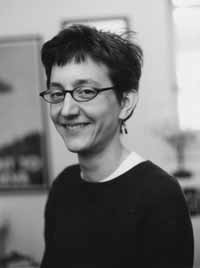The Urban Science Education Center Makes Environmental Justice Come Alive in a Harlem Middle School
Calabrese Barton spoke about the challenges of improving science education in public schools and especially in the Harlem Middle School for Mathematics and Science (HMSMS). "In the end we are most interested in improving and enhancing the experiences that children get in school. We want to open up opportunities for them to enjoy science, to think critically about science in their lives, and to move into science careers if they want. We do a lot of work with teachers to improve the teaching experience so that the children have more opportunities to engage in inquiry-based, hands-on science."
"We want them to become excited about it, with opportunities to interact with scientists and role models who are from their community," she continued. "Look at the challenges that face kids in high poverty urban schools-they are not getting science often, they don't have resources, they don't have as many compensatory experiences-so we are trying to make science more personal, culturally relevant and empowering."
This African-American and Latino populated middle school that is located in a high poverty area will be growing from a fifth and sixth grade to include a seventh and eighth grade. Located off Lenox Avenue and 117th Street, HMSMS is working with Calabrese Barton, her Urban Science Fellows, and local museums and cultural organizations on a variety of projects to make science come alive to the school's students. This new District 3 middle school is the only one to focus on mathematics and science in the central Harlem community.
Along with Calabrese Barton, a team of Teachers College Urban Science Fellows-one is a doctoral student, two are student teachers and another is a Rose Fellow, who is funded by a former trustee, Elihu Rose, are engaged in projects at HMSMS. The fellows, who apply at the beginning of each academic year, are selected competitively. The fellowships are open only for those students who have an interesting commitment to working in high poverty urban schools.
During the afternoons, after the core academic subjects are concluded, the Urban Science Center is working specifically with HMSMS's science teachers on an interdisciplinary program where kids explore a particular question or issue in an interdisciplinary way, focusing on mathematics or science. Currently, Calabrese Barton is collaborating with the teachers to develop a curriculum for the school year that looks at environmental justice in the Central Harlem community. The curriculum materials developed will be shared with the Urban Science Centers other school partners, including MS 306 and the Science and Technology Center both in District 10, and with collaborating community organizations, such as the West Harlem Environmental Action Organization.
"Studying environmental justice is important to the curriculum and the students because we all want them to understand what it means to actually think about air, water and soil in the context of Central Harlem. What does it mean to be a student who has agency in their community? And how can you go about using this kind of information that you learned to make a change in your school and in your community?" said Calabrese Barton.
The school and the Urban Science Center are taking a three-pronged approach looking at air-quality, water quality and soil quality during the first half of the academic year.
The Air Quality project relies heavily on the cooperation of the West Harlem Environmental Action Center (WEACT), which has done curriculum development work around air-quality with real-time, real world data collection around the New York City area. WHEAC is assisting teachers at HMSMS to use and access data.
"With the Water Quality Project we are working with South Street Seaport because they have science equipment that the teachers don't have. Both of these organizations also provide places for the kids to go on field trips and provide scientists who can come into the school and talk about their work as well," said Calabrese Barton.
The Soil Quality Project is one that the Urban Science Center is working on exclusively with the teachers at HMSMS.
In the second half of the year the school will focus on another inter-disciplinary curriculum that will address building and studying recycling and urban gardens. HMSMS has the garden space but it's in disarray, and the principal wants to help the children apply what they've learned to transform that into a community garden. This project has grown out of the interest of the principal and the children themselves, who have expressed excitement and interest. This project is part of the after-school program that is being directed by the student teachers, which will give them an opportunity to practice teaching in ways that are not confined by the standard curriculum of classroom life.
"So what will come out of this," said Calabrese Barton, "is that we have student teachers who are learning how to do this kind of curriculum work with experienced teachers, we have experienced teachers that are learning how to integrate environmental justice into their inter-disciplinary curriculum, and we have community-based organizations who are able to share their expertise in terms of the equipment and scientific knowledge with that school community."
Published Monday, Feb. 10, 2003
